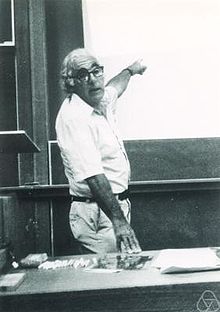Daniel Gorenstein
Daniel E. Gorenstein (born January 1, 1923 in Boston , † August 26, 1992 on Martha's Vineyard ) was an American mathematician who had a leading role in the program of the classification of finite simple groups , which in the 1980s a preliminary Concluded. He dealt with the theory of finite groups and commutative algebra. The Gorenstein rings are named after him, although he always claimed that he didn't even understand the definition.
Life
Gorenstein was a quarterback in football in high school. He studied at Harvard among others with Saunders MacLane . In 1950 he received his doctorate there under Oscar Zariski . After his dissertation, he went to Clark University in 1951 , where he stayed at Cornell University until 1964, except for a visiting professorship in 1958/59 , when he moved to Northeastern University in Boston . In 1968/69 he was at the Institute for Advanced Study . From 1969 he was a professor at Rutgers University , where he stayed until his death. From 1975 to 1981 he was chairman of the mathematics faculty there. From 1989 he was the founder and first director of the National Science Foundation Science Technology Center in Discrete Mathematics and Computer Science (DIMACS).
His change from algebraic geometry to group theory took place (partly under the influence of Israel Herstein ) around 1957 and his participation in the classification program of finite simple groups in the "Group Theory Year" 1960/61 at the University of Chicago, where John Griggs Thompson and Walter Feit developed their proof of solvability for groups of odd order. Gorenstein was the driving force behind the classification program of finite simple groups, supplemented in the 1970s by Michael Aschbacher , both through his own work and through his organizational talent and energetic personality . At the AMS meeting in 1981 Gorenstein announced that the classification program had been completed, but that turned out to be premature over the course of the decade. Gorenstein was also the initiator of the Second Generation Proof , a streamlined version of the proof of the classification theorem (GLS project) that is as complete as possible and published in a coherent series of publications . He worked on it in particular with Richard Lyons and Ronald Solomon until his death from lung cancer in his summer home on Martha's Vineyard. The 2nd generation proof should reduce the original proof from around 15,000 pages to 3,000 to 4,000. The first volume did not appear until 1994 after Gorenstein's death, and in 2005 about half of the planned 11 volumes were published with the sixth volume.
In 1972/73 he was a Guggenheim Fellow and a Fulbright Fellow. Since 1987 he has been a member of the National Academy of Sciences and since 1987 of the American Academy of Arts and Sciences . In 1989 he won the Leroy P. Steele Prize for his textbooks. In 1978 he gave a plenary lecture at the ICM in Helsinki (The Classification of Finite Simple Groups) and in 1970 he was invited speaker at the ICM in Nice (Centralizers of involution in finite simple groups).
Michael O'Nan is one of his PhD students .
Fonts
- Finite Groups. Harper and Row, 1968, AMS Chelsea Publishing 2007.
- Finite simple groups: An introduction to their classification. Kluwer / Plenum, New York 1982.
- with Kōichirō Harada : Finite simple groups whose 2-subgroups are generated by at least 4 elements. Memoirs AMS 1974
- with Richard Lyons : The local structure of finite groups of characteristic 2 type. 1983
- with Richard Lyons, Ronald Solomon : The classification of the finite simple groups. AMS, 6 volumes, 1994 to 2005
- The classification of finite simple groups I. Simple groups and local analysis. In: Bulletin AMS. 1979, No. 1.
- The Classification of the Finite Simple Groups. A personal journey: the early years, in: Peter Duren (Ed.), A century of mathematics in America, Volume 1, American Mathematical Society 1998
literature
- Mark Ronan: Symmetry and the Monster. Oxford University Press, 2006.
- Ronald Solomon: A brief history of the classification of the finite simple groups , Bulletin AMS, Volume 38, 2001, pp. 315–351
Web links
- Gorenstein at the Mathematics Genealogy Project
- John J. O'Connor, Edmund F. Robertson : Daniel Gorenstein. In: MacTutor History of Mathematics archive .
Individual evidence
- ^ D. Eisenbud: Commutative Algebra. Springer, 2004, ISBN 0-387-94269-6 , p. 530.
- ^ Garrett Birkhoff , Interview in Albers, Alexanderson, Mathematical People
- ↑ Stephen Ornes, The whole universe catalog , Scientific American, July 2015
- ↑ Ronald Solomon, The Classification of finite simple groups: A progress report , Notices AMS, June / July 2018, online
| personal data | |
|---|---|
| SURNAME | Gorenstein, Daniel |
| ALTERNATIVE NAMES | Gorenstein, Daniel E. |
| BRIEF DESCRIPTION | American mathematician |
| DATE OF BIRTH | January 1, 1923 |
| PLACE OF BIRTH | Boston |
| DATE OF DEATH | August 26, 1992 |
| Place of death | on Martha's Vineyard |
